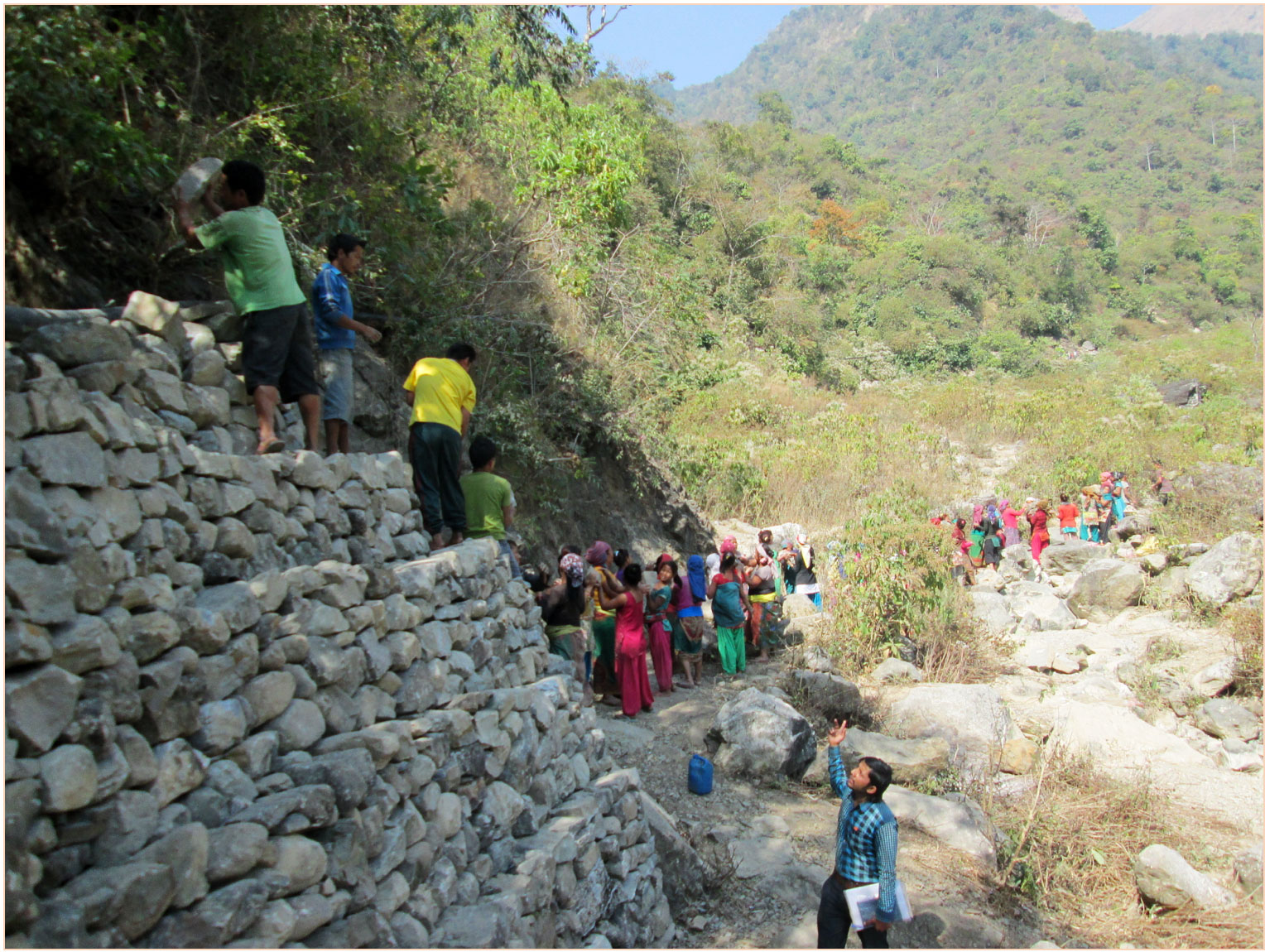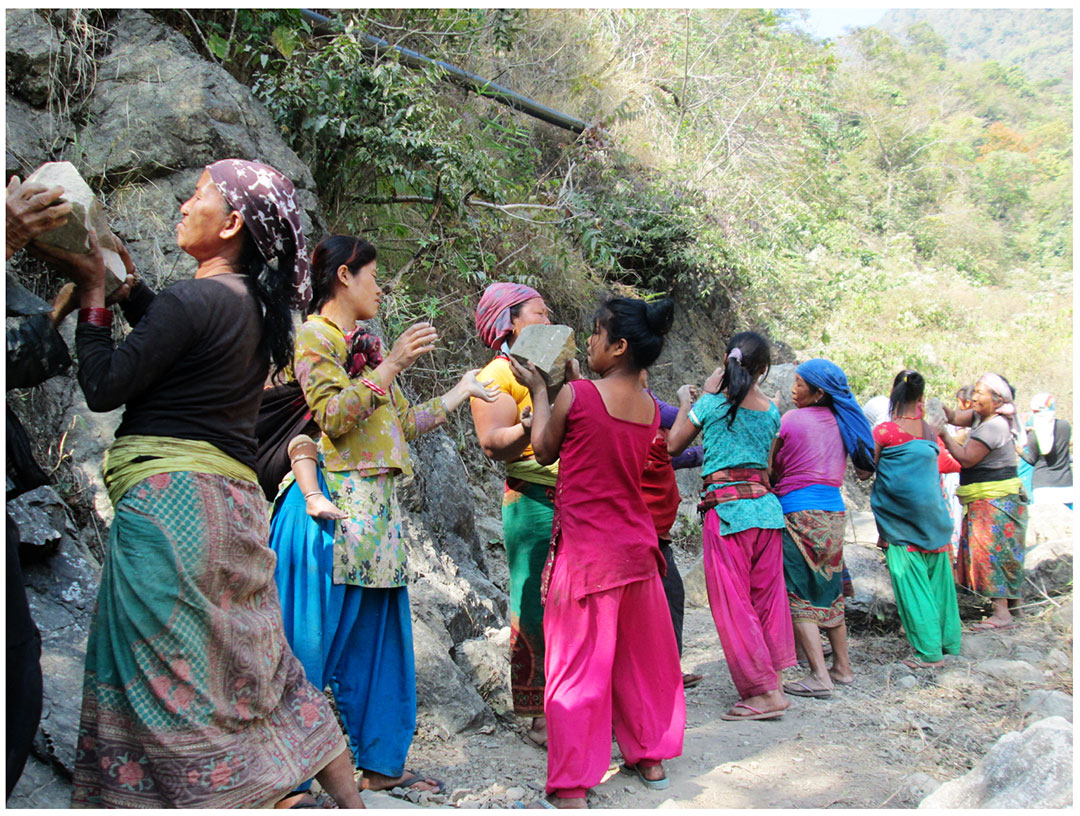Floating Gardens of Bangladesh: A Community Based Adaptation for Combating Climate Change
Context
Bangladesh is one of the world’s poorest countries, criss-crossed by more than 230 of the world’s most unstable rivers. For poor families living in rural Bangladesh land is a scarce commodity and people have to make use of whatever space is available. Each year the situation is exasperated by flooding which restricts the time that crops can be grown. Floods affect over one million people in the country and more than 100,000 women, men and children are forced to move as villages and livelihoods are literally washed away. In recent years, flooding has intensified and lasted longer and now the fields can be submerged for far longer than the traditional two months. During the monsoon season, much of the farm land in Southern Bangladesh is covered by water, making it impossible to grow crops. Even when the floods recede, the land remains waterlogged restricting people’s ability to cultivate vegetables to feed themselves and to generate an income, particularly when land is flooded and other cultivation options are unavailable.
Given the outlook of potential climate change, floating gardening could indeed be a suitable and successful coping option. Floating gardening in Bangladesh is a case of “mass fascination” overpowering the reality. That is why, despite so much interest from different areas, there is hardly any research on the links between floating gardening and climate change. The power of vulnerable communities and their traditional knowledge and practices have repeatedly been highlighted in the discussions on community-based adaptation. But the strengths and limitations of floating gardening under local climate change,
climate variability and disaster risk reduction contexts have not been understood through proper study.
About the coping and adaptation strategy behind “Floating Gardens”
Considering the potential of climate change to destroy the Earth and affect the livelihood, Bangladesh is already facing major problem of food shortage and population outburst. With limitation of resources, funds and livelihood options people have now started realizing importance and adapting to the traditional age-old practice agro-practice “Floating Gardens”. Practical Action in association of other NGO’s is trying to revive this community based traditional adaptation practice. Floating gardens are amongst the many options developed and promoted to address the needs of poor farmers in Bangladesh combining to make a real difference to production levels.
What it is?
A floating garden is built using aquatic weeds as a base on which vegetables can be grown. This approach can extend the growing capabilities of rural communities where land would otherwise be unavailable. It is cheap and sustainable.
How it works?
A floating garden is built using water hyacinth, which is collected to construct a floating raft. This is covered with soil and cow dung, in which vegetables can be planted. A new raft needs to be built every year, but the old one can be used as fertilizer during the dry season.
The rafts, eight meters long and one meter wide, are made from hyacinth, which is available for free locally. Soil is put on the surface of the raft and then the seeds planted in the soil. Summer and winter vegetables such as gourd, okra and leafy vegetables are grown.
The floating gardens provide food for people even during the annual monga (period of food shortages) and they can also provide an alternative source of income through sale of any surplus in the market. They are suitable for farmers who need to diverse from traditional land use, and, as the rafts can be moved from place to place, they are also suitable for those that have temporarily or permanently lost their homes and land.
The floating vegetable gardens are also created in ponds, canals and other water sources.
Training is provided in new techniques to cope with the conditions, grow more and better crops, and throughout the year. People are shown how to protect against plant disease and insect attack using organic control methods (e.g. homemade botanical insecticide). Advice is also given in making seed-beds, preparing compost and enriching the sandy soil with compost and manure. The crops not only provide vital food but any surplus can be sold to generate an income.
How it reduces climate risk or vulnerability? What co-benefits it generates?
Over the last decade climate change has been affecting monsoon patterns in South-East Asia. Monsoon has become highly unpredictable and irregular owing to which there are frequent flood like situation. Farming and livestock is entirely dependent on Monsoon making it more vulnerable to sustain.

Entire population dependent on Monsoon here can be considered as a stakeholder. But women enthusiastically participated in the project since they are the primary stakeholders in the project. The women in the project villages have formed the SHGs to make sustainable and concerted efforts for scaling the process up.
For a poor and underdeveloped country like Bangladesh it was very much necessary to find out cheaper and fairly acceptable solutions which could easy to be adapted by farming community widely. This was promising only by reviving back age old traditional wisdom which offers above advantages making livelihood sustainable in such diverse yet deterrent conditions. Co-benefits rising out from Floating Gardens are being a community based adaptation practice it is restricting the migration; by providing sustainable farming poverty alleviation is observed; appropriate and ample food production is complementing livelihood security.
The intervention has brought about a change in their living condition by enhancing the income even during the distressed periods of monsoon season. The nutrition security of the household has been restored along with livelihood security of both men and women.
A Practical Approach for Capacity and Resilience Building
Practical Action, Bangladesh started this initiative in July 2005 by direct implementation with the community participation sponsored by BCAS, CARE and IUCN. Most of the project areas are still functional even after withdrawal of support since last 10 years. The proliferation and recognition by the civil society and government has established the potentiality of the system to a great extent. These systems are being adopted and owned by the community especially the women, thus the women can be considered as the driving force among the community. There was no subscription charge from the community neither any matching grant from any corporate of private sector. However the villager’s suo-moto contributed locally sourced materials for the construction of the beds.

Appreciation, Challenges and way forward
Impacted by our innovation the national government in Bangladesh has come forward to implement the technique, for example, the National Adaptation Programme of Action (NAPA, 2005) of Bangladesh identified promotion of floating gardening as one of its 15 adaptation projects. The revised NAPA (2009) also recognized the potential of this traditional practice. But it was only in early 2013 that the Government of Bangladesh approved a US$ 1.6 million project under its Bangladesh Climate Change Trust Fund (BCCTF) to promote floating gardening for climate change adaptation. This 3-year project will be implemented by the Government’s agricultural extension wing in 40 sub-districts of 8 districts all over the country.
Challenges lies in the areas identified for the project were poor and water logged ones, getting the people for the initial arrangements were quite difficult for us in the formative months. Once they realized the potential of the farming technique, the skepticism has evaporated.
One of the important lessons learnt in this process is that, small Ideas can have the potential to bring in remarkable change in the lives of poor.
[/fusion_text][fusion_separator style_type=”single solid” hide_on_mobile=”small-visibility,medium-visibility,large-visibility” class=”” id=”” sep_color=”#8bc34a” top_margin=”10px” bottom_margin=”5px” border_size=”3″ icon=”” icon_circle=”” icon_circle_color=”” width=”” alignment=”center” /][fusion_text] The case studies compendium research and coordination was supported with funding and technical input by Oxfam through its Asia Resilience Hub.
The case studies compendium research and coordination was supported with funding and technical input by Oxfam through its Asia Resilience Hub.
PARTNERS
[/fusion_title][fusion_portfolio layout=”carousel” picture_size=”default” boxed_text=”unboxed” columns=”3″ one_column_text_position=”below” column_spacing=”20″ number_posts=”8″ portfolio_title_display=”all” portfolio_text_alignment=”left” portfolio_layout_padding=”” filters=”yes” cat_slug=”partners-case-studies” exclude_cats=”” pagination_type=”none” hide_url_params=”off” offset=”0″ content_length=”excerpt” excerpt_length=”35″ strip_html=”yes” carousel_layout=”title_on_rollover” scroll_items=”” autoplay=”yes” show_nav=”yes” mouse_scroll=”no” hide_on_mobile=”small-visibility,medium-visibility,large-visibility” class=”” id=”” animation_type=”fade” animation_direction=”left” animation_speed=”0.3″ animation_offset=”” /][/fusion_builder_column][/fusion_builder_row][/fusion_builder_container]




